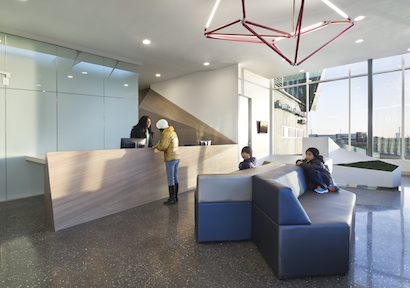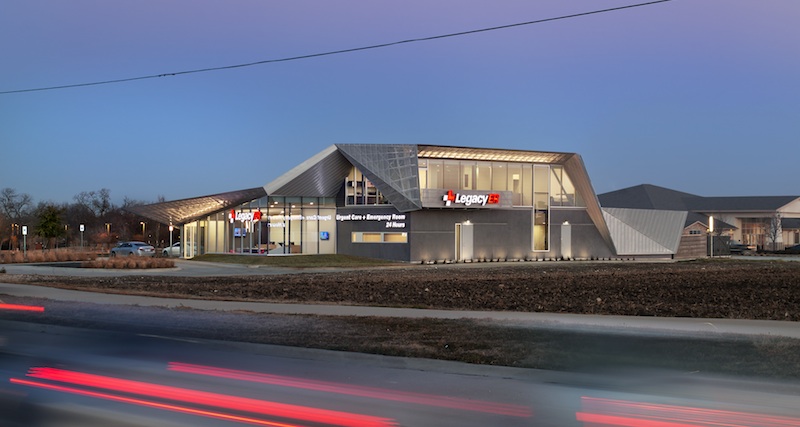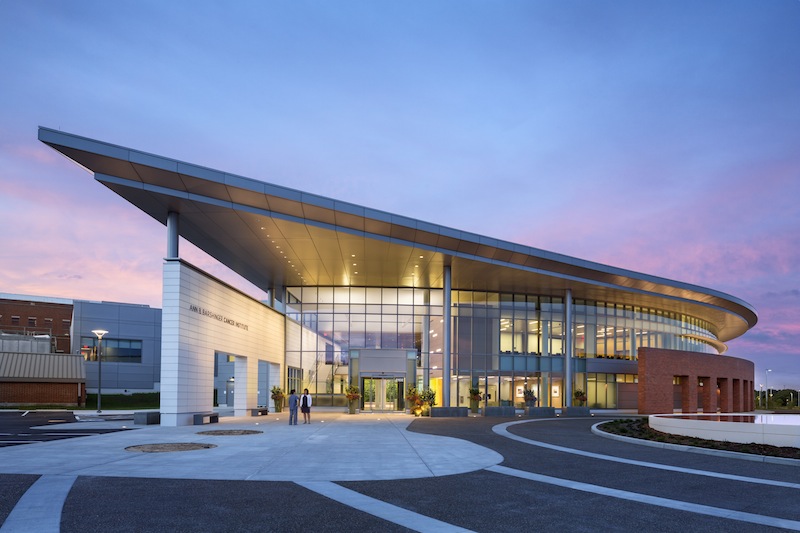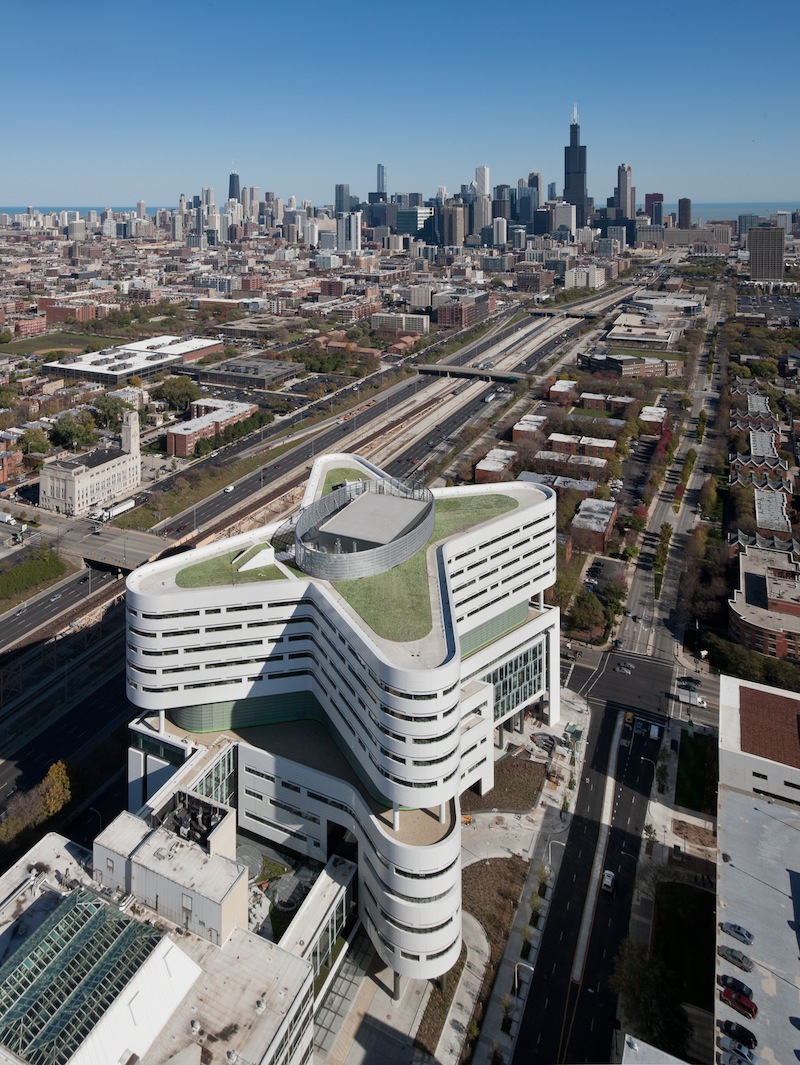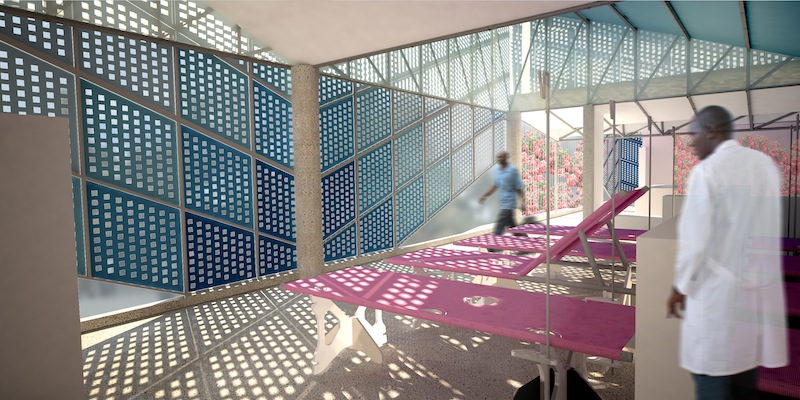The American Institute of Architects Academy of Architecture for Health has selected the recipients of the AIA National Healthcare Design Awards program. The AIA Healthcare Awards program showcases the best of healthcare building design and healthcare design-oriented research.
Projects exhibit conceptual strengths that solve aesthetic, civic, urban, and social concerns as well as the requisite functional and sustainability concerns of a hospital.
Recipients were selected in four different categories:
Category A: Built, Less than $25 million in construction cost
Category B: Built, More than $25 million in construction cost
Category C: Unbuilt, Must be commissioned for compensation by a client with the authority and intention to build
Category D: Innovations in Planning and Design Research, Built and Unbuilt
Jurors for the 2014 National Healthcare Design Awards include: Eric Goodfriend, AIA (Chair), Mahlum; Roger Call, AIA, Herman Miller for Healthcare; Jim Lennon, Lennon Associates; James C. Lord II, AIA, KGA Architecture; Mark Patterson, AIA, SmithGroupJJR; Mark Tortorich, FAIA, Stanford University and Shane Williams, AIA, Array Architects.
Category A
Legacy ER – Allen; Allen, Texas
5G Studio Collaborative
Legacy ER operates a hybrid program offering urgent and 24/7 state-licensed emergency care services within a freestanding building. Conceptualized as a potent reflection of the organization’s identity, the architecture captured the duality of the emergency medical professionals' character, projecting outwardly the knowledge, skill, precision, and decisiveness necessary for the competent practice of emergency medicine and expressing inwardly the gentle, empathic, and humanistic qualities of the persons beneath the robe, realized simply through montaging sharply folded exterior robe of zinc and softly sculpted interior plastered planes. Points of admission of natural daylight and views create apertures that elucidate intersecting tectonic moments.
Lightwell: Greater Boston Orthodontics; Waltham, Massachusetts
Merge Architects

Photo: John Horner Photography
A hundred-year-old storefront and warehouse on Main Street in Waltham was gutted, creating an open plan orthodontic clinic – including reception and treatment areas flanked by semi-private offices, toothbrushing stations, exam rooms, and a staff coffee area. The double-height treatment space is framed by an 18-foot-tall backlit translucent wall curving down in section to frame and light the open treatment area. CNC-cut plywood ribs skinned with thin polycarbonate panels funnel light from skylights above. The front waiting space is defined by a custom seating area and digital media bar, wool felt applied to walls, a custom light pendant, and bright custom wall graphics to provide wayfinding.
Category B
Lancaster General Health Ann B. Barshinger Cancer Institute; Lancaster, Pennsylvania
Ballinger
The new 100,000 square foot Ann B. Barshinger Cancer Institute is developed around a progressive model for cancer care and employs an interdisciplinary and patient-centric approach. Focused on regeneration and reconnection to living systems, the building’s radial form derives from an existing elevated, curvilinear arrival / parking court which has become a central courtyard healing garden. The expanded oncology program is arrayed around the garden on two levels. Glazed skins and multiple points of access provide a continuous dialogue between interior and exterior, creating a visually open environment that reduces anxiety and stress for patients and their families.
Mount Sinai Hess Center for Science and Medicine; New York City
Skidmore, Owings & Merrill LLP
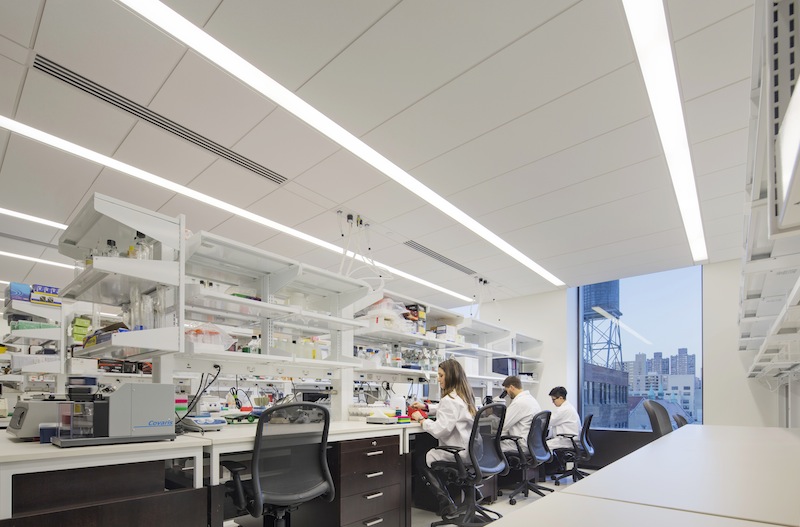
Photo © Eduard Huebrer / Archphoto
Envisioned as a place of discovery and healing, the striking Mount Sinai Hess Center for Science and Medicine is shaped by its translational research mission and urban context. Located in Upper Manhattan, the center places researchers, clinicians, educators, and patients in an integrated environment with state-of-the-art technology. The 420,000 square foot facility is specifically designed to foster multi-disciplinary interaction through a network of formal and informal settings. The primary design objective was to craft a flexible environment that would be inspiring and supportive for employees while gracious and dignified for patients and their families. Inside, natural light and a warm, simple material palette puts cancer patients at ease.
Rush University Medical Center New Hospital Tower; Chicago
Perkins+Will
As part of Rush University Medical Center’s 10-year, $1 billion Campus Transformation Project, Perkins+Will planned and designed a new 840,000 square foot state-of-the-art hospital building. Crowned by a butterfly-shaped bed tower designed to minimize steps between staff and patients, the new hospital is comprised of 304 acute and critical care beds, 72 neonatal intensive care beds, and 10 labor and delivery beds. The emergency department contains one of the country’s few bioterrorism preparedness facilities, and is designed to handle large-scale health emergencies. The hospital is one of the largest in the world to be certified LEED Gold.
Category C
Children’s Hospital of Richmond Pavilion (CHoRP); Richmond, Virginia
HKS, Inc.
At the gateway to the medical campus, the Children’s Hospital of Richmond Pavilion consolidates existing pediatric clinics into a compact vertical urban pavilion. The facility is dedicated to providing comprehensive healthcare for children and adolescents and contains a surgery level, three levels of pediatric clinics, a faculty/research floor, and seven levels of parking. Adjacent to some of the city’s most important civic structures, the design establishes a signature identity that embodies VCU’s objective of becoming the region’s premier pediatric academic medical institution. Drawing inspiration from natural elements that are unique to the City of Richmond, the design is intrinsically tied to its location. Themes of sky, water, and forest bring nature to the heart of this urban campus.
Category D
Cincinnati Children's Family Pet Center; Cincinnati, Ohio
GBBN Architects
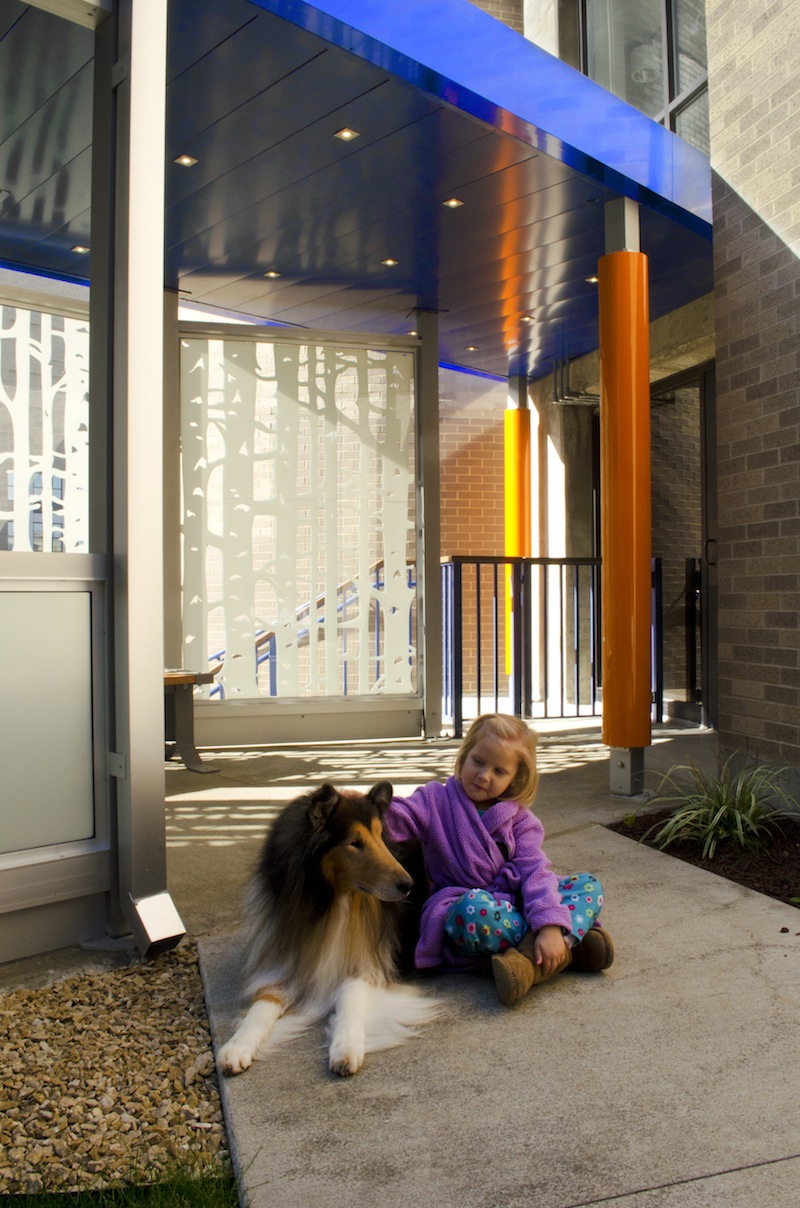
Courtesy Cincinnati Children's Hospital
The Family Pet Center expands the hospital’s pet therapy program with a 250-sf pavilion and lawn areas that accommodate patients whether on foot, in a wheelchair or on a stretcher. In this 8’ by 10’ enclosure, kids reunite with their own pets. Positive effects begin with anticipation days in advance, the visit itself, and the lingering effects of memories or storytelling afterwards. Based on research on the healing benefits of Animal Assisted Therapy (AAT), this pavilion addresses the medical needs of the children and the physical dynamics of pets. Especially for cancer patients, who deal with high levels of stress, pain, and long hospital stays, AAT contributes to recovery by improving the quality of life for patients.
GHESKIO Cholera Treatment Center (CTC); Port-au-Prince, Haiti
MASS Design Group
The first permanent facility in Port-au-Prince, the CTC provides an aggressive model for cholera treatment, while creating a healing space that promotes a dignified patient experience. Both the CTC’s layout and placement of amenities optimize staff and patient flow. The design tackles unique site conditions, including the lack of reliable piped water and lack of sewer system connection, by providing off-the-grid services. The roof collects rainwater, which is stored in cisterns, chlorinated, and then used for showers and sinks. The facility also decontaminates waste on-site and is designed to achieve 99.99% removal and inactivation of Cholera vibrio and other pathogenic organisms. The façade blends the use of the most advanced technology, using parametric modeling to optimize apertures for daylighting, ventilation, and privacy, with deploying analog techniques for local fabrication. The CTC will not only establish new standards for cholera treatment, but also new standards for quality construction in Haiti.
The video provides more information.
Building Better Builders from MASS Design Group on Vimeo.
Related Stories
Student Housing | Feb 19, 2024
UC Law San Francisco’s newest building provides student housing at below-market rental rates
Located in San Francisco’s Tenderloin and Civic Center neighborhoods, UC Law SF’s newest building helps address the city’s housing crisis by providing student housing at below-market rental rates. The $282 million, 365,000-sf facility at 198 McAllister Street enables students to live on campus while also helping to regenerate the neighborhood.
MFPRO+ News | Feb 15, 2024
UL Solutions launches indoor environmental quality verification designation for building construction projects
UL Solutions recently launched UL Verified Healthy Building Mark for New Construction, an indoor environmental quality verification designation for building construction projects.
MFPRO+ News | Feb 15, 2024
Nine states pledge to transition to heat pumps for residential HVAC and water heating
Nine states have signed a joint agreement to accelerate the transition to residential building electrification by significantly expanding heat pump sales to meet heating, cooling, and water heating demand. The Memorandum of Understanding was signed by directors of environmental agencies from California, Colorado, Maine, Maryland, Massachusetts, New Jersey, New York, Oregon, and Rhode Island.
MFPRO+ News | Feb 15, 2024
Oregon, California, Maine among states enacting policies to spur construction of missing middle housing
Although the number of new apartment building units recently reached the highest point in nearly 50 years, construction of duplexes, triplexes, and other buildings of from two to nine units made up just 1% of new housing units built in 2022. A few states have recently enacted new laws to spur more construction of these missing middle housing options.
Green | Feb 15, 2024
FEMA issues guidance on funding for net zero buildings
The Federal Emergency Management Agency (FEMA) recently unveiled new guidance on additional assistance funding for net zero buildings. The funding is available for implementing net-zero energy projects with a tie to disaster recovery or mitigation.
Hospital Design Trends | Feb 14, 2024
Plans for a massive research hospital in Dallas anticipates need for child healthcare
Children’s Health and the UT Southwestern Medical Center have unveiled their plans for a new $5 billion pediatric health campus and research hospital on more than 33 acres within Dallas’ Southwestern Medical District.
Architects | Feb 13, 2024
Pierluca Maffey joins Carrier Johnson + Culture as new Firmwide Head of Design
Carrier Johnson + Culture (CJ+C) has hired Pierluca “Luca” Maffey, International Assoc. AIA, as the firm's new Firmwide Head of Design and Design Principal.
K-12 Schools | Feb 13, 2024
K-12 school design trends for 2024: health, wellness, net zero energy
K-12 school sector experts are seeing “healthiness” for schools expand beyond air quality or the ease of cleaning interior surfaces. In this post-Covid era, “healthy” and “wellness” are intersecting expectations that, for many school districts, encompass the physical and mental wellbeing of students and teachers, greater access to outdoor spaces for play and learning, and the school’s connection to its community as a hub and resource.
Office Buildings | Feb 13, 2024
Creating thoughtful tech workplace design
It’s important for office design to be inspiring, but there are some practical principles that can be incorporated into the design of real-world tech workplaces to ensure they convey an exciting, sophisticated allure that accommodates progressive thinking and inventiveness.
Airports | Feb 13, 2024
New airport terminal by KPF aims to slash curb-to-gate walking time for passengers
The new Terminal A at Zayed International Airport in the United Arab Emirates features an efficient X-shape design with an average curb-to-gate walking time of just 12 minutes. The airport terminal was designed by Kohn Pedersen Fox (KPF), with Arup and Naco as engineering leads.


